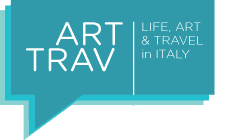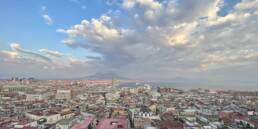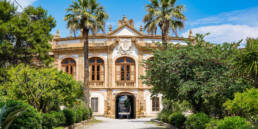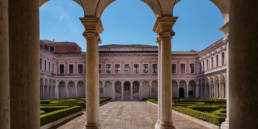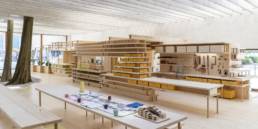Pretty, pop, delicious, social. A new exhibit at the MART in Rovereto seems to show that the key to getting people into the museum is to talk about food. Or to talk about food as art, or food in art. How to draw crowds is a dilemma that all museums face now, more than ever, and the solution has often involved turning to two ‘popular’ themes – fashion and food. The trick is to do it well, in a way that is academically valid and not a sell-out. Thankfully, the MART has done a good job.

I stopped at the MART, on the way back from a recent stay in the Dolomites, specifically to see this exhibit. Having seen the photos and material on Facebook, where I have been following the MART for years, I found the objects interesting but wanted a sense of the layout and the overall show, something I could not get online. I also wondered how the museum dealt with the challenge I pose above – not ‘selling out’. As an art and culture blogger, I have often found it frustrating that my writing remains specific to a relatively small niche, while I see food and fashion bloggers crop up and become famous (some with material of dubious quality, others worthy of their fame). I have always said that it is easier for people to relate to food, since we all eat. Communicating art is more of a challenge, and for most people, art and the visual is not so essential (or they don’t realize it, anyway). So is the answer to this problem to write about – or to exhibit – food and art?

Progetto cibo is about the conjunction between design and food, explored through various clever declinations, from food itself as naturally designed, to food being used in design, and design for food. The display of this show is very clever: large white, geometric tables at the center of each room display the food and objects, most of which are not protected by glass, playing on a sense of accessibility that is more subject-appropriate than museumifying the objects in glass cases and pedestals. The walls are painted a contrasting black with white writing and diagrams that are part of the exhibit, even if no artist is credited here. The graphic concept of the show is overall really great. With the only negative being that texts are only in Italian.

Working one’s way through this exhibit is like a discovery in pleasure. The food and objects play on the way that memory triggers an oral response, causing often happy associations or watering mouths. In fact, it would have been wise to eat lunch before seeing the show as I risked drooling on the display.

We start out with a hilarious interpretation of the orange by Bruno Munari in his book Good design, which kicks off the idea that food, in itself, is designed. There’s a section dedicated to bread and its many shapes. Then we see how, especially from the 1950s onwards, certain foods are increasingly engineered; this is visible in the food items themselves as well as a series of patent office records showing drawings for things like the perfect drip-free ice-cream cone. A colourful assortment of candies is laid out in a hypnotically repetitive pattern in which we can pick out tic-tacs, Smarties, Baci and other yummy favourites. This is where I started to get hungry.

From designed food we move on to edible objects that serve double purposes, like sugar spoons. And from there towards food and play, objects like chocolate rulers and lego-type blocks. Museum-goers stop to point and share their joy with friends as they figure out how the objects work. It’s a social experience, certainly an exhibit to see in good company.

Humour plays a big role in food-art, where shape and material are unexpected, producing often beautiful but weird effects, like the jelly St. Paul’s cathedral, below.

The show overall is beautiful and has an appealingly contemporary, designer, and pop aesthetic. Unquestionably it’s an exhibit that has wider appeal than the concurrent show on the aesthetic of the educational reformist, Rudolf Steiner, but in no way does the curator, Beppe Finessi, lower the educational value of the museum here. Quite the contrary, we left having learned a few designers’ names, discovered numerous facts, and looking at food and design in a new way.

I am always attentive to how museums manage their social media, and the MART has always been my number one example from Italy (the competition is sadly not very strong). MART’s communications department has taken advantage of the potential of the web to diffuse images of food and conversation about it to the max. They’ve started a pinterest board and a Tumblr dedicated to the exhibit. On the facebook page, photos, videos and links to press articles receive good interaction. Real world social life is encouraged by a series of events including cooking demonstrations by famous chefs and workshops for kids and adults to make anything from cookies to easter eggs. The museum is alive and well attended, both online and in physical space. And part of that secret, I am convinced, has to do with the food.

Visitor Information
Progetto Cibo: La forma del gusto
From February 9 to June 2, 2013
Mart Rovereto
Corso Bettini, 43 38068 Rovereto (TN)
www.mart.trento.it
Opening hours: Tues. – Sun. 10 a.m. – 6 p.m., Fri. 10 a.m. – 9 p.m.
NOTE – thanks to interaction in the comments below with the museum, here is a really beautiful video of the freehand drawing on the wall by young designers from Housatonic.
Sign up to receive future blog posts by email
Alexandra Korey
Alexandra Korey aka @arttrav on social media, is a Florence-based writer and digital consultant. Her blog, ArtTrav has been online since 2004.
Related Posts
September 11, 2023
An art historian’s approach to things to do in Naples, Italy
June 22, 2023
4 day trips from Palermo up the Tyrrhenian coast
September 20, 2021
